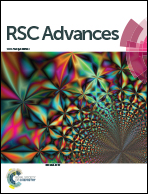Lipase-catalyzed green synthesis of enantiopure atenolol†
Abstract
A new green route is proposed for the synthesis of enantiopure atenolol (a β1-blocker). An enzymatic kinetic resolution approach was used to synthesize the enantiopure intermediates (R)- and (S)-2-(4-(3-chloro-2-hydroxypropoxy)phenyl)acetamide from the corresponding racemic alcohol. Of the commercially available lipases screened, Candida antarctica lipase-A (CLEA) showed maximum enantioselectivity in the transesterification of the racemic alcohol using vinyl acetate as the acyl donor. The reactions afforded the (S)-alcohol along with the (R)-acetate, with 48.9% conversion (E = 210, eeP = 96.9% and eeS = 91.1%). Various reaction parameters were optimized in order to achieve maximum enantioselectivity. N-alkylation of the (S)-alcohol with isopropylamine afforded the (S)-atenolol, and the (R)-acetate was chemically hydrolyzed to the corresponding alcohol and further converted to the (R)-atenolol via N-alkylation of the (R)-alcohol with isopropylamine. The use of ionic liquids, to solve the solubility related problems of the drug intermediates, made this process greener and more efficient compared to the previously reported methods.


 Please wait while we load your content...
Please wait while we load your content...